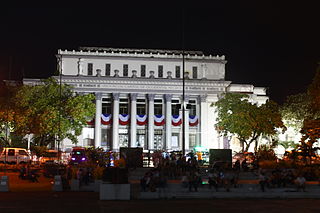
Negros Occidental is a province in the Philippines located in the Western Visayas region. Its capital is the city of Bacolod. It occupies the northwestern half of the large island of Negros, and borders Negros Oriental, which comprises the southeastern half. Known as the "Sugarbowl of the Philippines", Negros Occidental produces more than half the nation's sugar output..
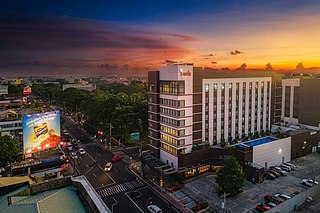
Bacolod, officially the City of Bacolod, is a 1st class highly urbanized city in the region of Western Visayas, Philippines. It is the capital of the province of Negros Occidental, where it is geographically situated but governed administratively independent.

Silay, officially the City of Silay, is a 3rd class component city in the province of Negros Occidental, Philippines. According to the 2020 census, it has a population of 130,478 people.

The Republic of Negros was a short-lived revolutionary entity which had existed on the island of Negros first as a canton of the First Philippine Republic and later as a protectorate of the United States.

The Negros Revolution, commemorated and popularly known as the Fifth of November or Negros Day, was a political movement that in 1898 created a government on Negros Island in the Philippines, ending Spanish control of the island and paving the way for a republican government run by the Negrense natives. The newly established Negros Republic lasted for approximately three months. American forces landed on the island unopposed on February 2, 1899, ending the island's independence. Negros was then annexed to the Philippine Islands on 20 April 1901.

Colonel Dionisio Magbuelas, Dionisio Seguela or Dionisio Papa y Barlucia, more widely known as Papa Isio, was the leader of a group of babaylanes who were, as conjectured by Modesto P. Sa-onoy, recruited from the remnants of the followers of Dios Buhawi upon the dissolution of his group under the poor leadership of Camartin de la Cruz during the years prior to the onset of the Philippine Revolution.
The Bacolod Arts and Youth Sports Center is a multi-use gym located in Bacolod, fronting the Bacolod Public Plaza, in Negros Occidental, Philippines. It is used mostly for basketball, karatedo and boxing matches, and was used in events in the city like the MassKara Festival activities and other government related activities like seminars, business and political gatherings.

The Capitol Park and Lagoon is a provincial park located in Bacolod, Negros Occidental, in the Philippines. One of the features of the park are matching sculptures depicting a woman standing alongside a water buffalo and that of a man pulling another water buffalo. These sculptures are located at the northern and southern ends of the lagoon. These figures were executed by Italian sculpture Francesco Riccardo Monti who also did the sculptures of the Metropolitan Manila Theater and the University of the Philippines - Visayas Iloilo campus. Guillermo Tolentino also contributed as a sculptor of the figures.
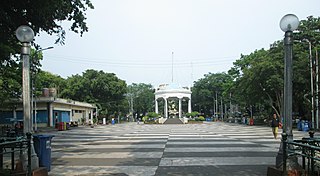
The Bacolod Public Plaza, officially the Plaza del 6 de Noviembre, named after the day of the Spanish surrender of Negros Island to the Negros revolutionaries, is one of the notable landmarks of Bacolod, the capital of Negros Occidental, Philippines. It is located in the heart of the downtown area, near the old city hall and across from the San Sebastian Cathedral. The plaza is a trapezoidal park with a belt of trees around the periphery and a gazebo at the center. Scattered within the trees are four circular fountains.
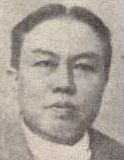
Antonio Ledesma Jayme was a Filipino lawyer, revolutionary hero, Governor of Negros Occidental, and assemblyman, as well as a lawmaker and a revolutionary nation's founding father and a signatory to a nation-state's constitution.

The Bacolod Metropolitan Area, simply known as Metro Bacolod, is the 8th-most populous and the 6th-most densely populated metropolitan area out of the 12 metropolitan areas in the Philippines. This metropolitan area as defined by the National Economic and Development Authority (NEDA) has an estimated population of 1,435,593 inhabitants as of the 2020 official census by the Philippine Statistics Authority.
A special election for Negros Occidental's 5th district seat in the House of Representatives of the Philippines was on June 2, 2012. The special election was called after incumbent representative Iggy Arroyo died on January 26, 2012. Binalbagan Mayor Alejandro Mirasol defeated Negros Occidental Provincial Board Member Emilio Yulo in the election.
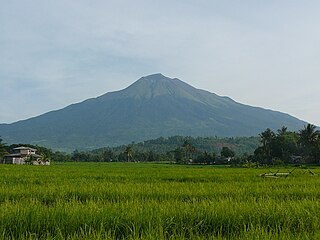
Negros is the fourth-largest and third-most populous island in the Philippines, with a total land area of 13,309 km2 (5,139 sq mi). Negros is one of the many islands of the Visayas, in the central part of the country. The predominant inhabitants of the island region are mainly called Negrenses. As of 2020 census, the total population of Negros is 4,656,945 people.
MassKara Festival Queen is a local beauty pageant in Bacolod, Negros Occidental, Philippines. Begun in 1981, it is one of the highlights of a week-long celebration called the MassKara Festival.

The Negros Occidental Provincial Capitol is the seat of the provincial government of Negros Occidental located at Gatuslao St., Bacolod, Philippines. Within its complex is the Capitol Park and Lagoon.
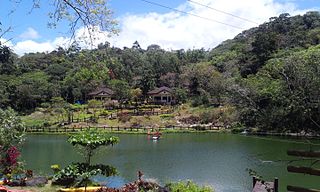
Mambukal Resort, officially the Township of Mambukal or simply known as Mambukal, is a resort township located within the boundaries of the municipality of Murcia, Negros Occidental. As a township, it is directly governed by the Provincial Government of Negros Occidental, which also manages Mambukal Mountain Resort in the 6-hectare townsite near Brgy. Minoyan. The resort is owned and managed by the Provincial Government of Negros Occidental under its Economic Enterprise Development Department.

Capitol Central, previously called the Negros Occidental Provincial Capitol Complex, is a government complex and mixed-use estate centered around the Negros Occidental Provincial Capitol, currently co-managed with Ayala Land. Certain portions are leased or sold to Ayala Land, as part of their industrial estate in Bacolod, Philippines.

The Negros Island Region, also abbreviated and officially designated as NIR, was a short-lived administrative region in the Philippines which comprised the provinces of Negros Occidental and Negros Oriental, both of which are part of the island of Negros. It existed from May 29, 2015 to August 9, 2017. Local officials and the Consultative Committee to Review the 1987 Constitution have proposed to reinstate Negros as a region or state of a Philippine federation.

The Panaad Park and Sports Complex(Tagalog: [ˈpɐnaʔad]), also known as the Panaad Park and Stadium or the Panaad Sports and Recreational Park, is a park in Bacolod, Negros Occidental, Philippines owned by the Provincial Government of Negros Occidental. It also hosts a sports complex with a stadium. The park is known as the main venue of the Panaad Festival since its establishment in the late 1990s.
José Ruiz de Luzuriaga was a Filipino judge, sugar planter, revolutionary and politician. Luzuriaga was a member of the Philippine Commission from 1901 to 1913.


















